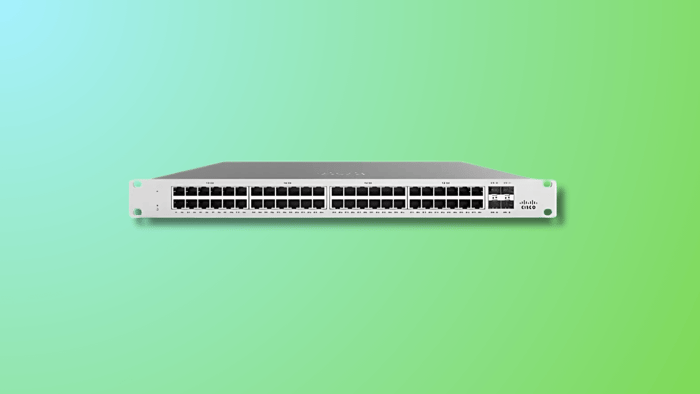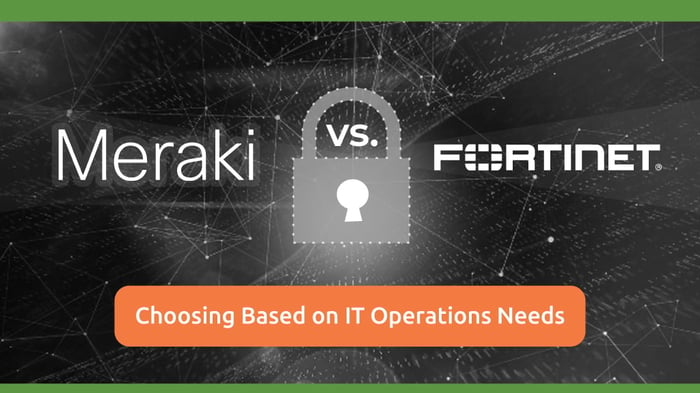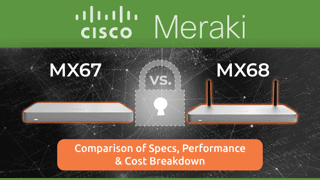Meraki Vs Cisco: Choosing Based on IT Operations Needs
Table of Contents
- Comparing the Key Features of Meraki vs Cisco
- Platform Setup, Provisioning, and IT Workflow Efficiency
- Security Architecture and Threat Protection
- Monitoring and Automation Tools for Network Visibility
- Integration Capabilities Across Platforms
- Licensing Structure
- Which Network Solution Supports Your Infrastructure Best?
- Leverage Expert Support to Optimize Your Network Choice
- FAQs
Meraki vs Cisco - both power enterprise networks, but they’re built on different operating philosophies. Cisco offers deep control, maximum customization, and enterprise-grade complexity. Meraki, on the other hand, was built for simplicity: centralized cloud control, intuitive interfaces, and plug-and-play provisioning.
If you’re deciding between the two, you’re not just picking hardware; you’re deciding how your IT team will manage, monitor, and scale the network over time. This guide breaks down what sets Cisco and Meraki apart, helping you make an informed decision based on your real operational needs.
Comparing the Key Features of Meraki vs Cisco
Before diving into the technical details, let’s take a high-level view of the conversation. Meraki vs Cisco approach networking differently, which shows up in how they’re deployed, secured, licensed, and scaled.
Feature | Cisco | Meraki |
Management Model | On-premise, CLI/GUI-driven | 100% cloud-managed |
Security Architecture | Deep customizable stack | Pre-packaged, integrated stack |
Monitoring & Automation | NetFlow, SNMP, DNA Center | Cloud-based dashboard & automation |
Integration Capabilities | Open, modular, deeply configurable | API-friendly, designed for simplicity |
Licensing Model | Device-based, perpetual, or subscription | Co-term, all-in-one subscription |
Each of these differences affects your IT team’s daily workflow and long-term flexibility. Let’s unpack them.
Platform Setup, Provisioning, and IT Workflow Efficiency
The setup speed and management complexity can make or break a deployment. Cisco’s model is built around local provisioning and control, which offers full customization but demands more time and skill. Meraki’s cloud-native model is designed for teams that want to be up and running quickly, without hands-on device management.
Management Model
Cisco provides administrators with full control over their environments, including CLI, SSH, GUI tools, and local configurations. This granularity is powerful for experienced engineers, but it also creates a heavier management burden.
Meraki centralizes everything in its cloud dashboard. You can configure, monitor, and troubleshoot from anywhere, and most changes apply instantly across the network.
Deployment with Provisioning Options
Cisco requires local staging, configuration scripts, and multiple touchpoints. That’s manageable with a large team, but not ideal for a lean IT organization.
Meraki hardware arrives nearly pre-configured. Claim devices in the dashboard, assign them to a network, and they auto-download settings when powered on. It's frictionless and fast.
User Experience in Configuration and Control
Cisco’s interface is designed for network pros. It’s robust but not always user-friendly. Troubleshooting often happens via the command line or third-party tools.
Meraki’s dashboard makes navigation simple, even for junior admins. Drag-and-drop configuration, live tools like packet capture, and simple templates streamline common tasks.
Security Architecture and Threat Protection
Security isn’t optional. The question is how much you want to configure versus how much you want to use a pre-built solution. Cisco allows for highly specific security stacks. Meraki delivers pre-integrated protection with minimal setup.
IPS/IDS Functionality
Cisco’s Firepower Threat Defense (FTD) enables you to create layered intrusion policies with tight control over detection thresholds. It’s powerful but demands hands-on tuning.
Meraki enables intrusion prevention with a few clicks. It uses Snort signatures and lets you choose between ‘Balanced,’ ‘Security,’ and ‘Maximum Security’ modes, no fine-tuning needed.
Advanced Malware Protection (AMP)
Cisco AMP integrates across routers, switches, and endpoints. You’ll get retrospective alerts and sandboxing, but configuration takes effort.
Meraki’s AMP is plug-and-play. Enable it in the dashboard, and it begins scanning and blocking malicious files immediately. It’s less customizable but faster to deploy.
Secure Tunneling & VPN
Cisco supports complex tunneling setups, including AnyConnect, DMVPN, IPsec, and more, making it ideal for enterprises with diverse requirements.
Meraki simplifies VPNs with Auto VPN. Branch-to-branch tunnels can be set up in seconds, and remote users connect with Meraki's Client VPN or integration with SAML and Duo.
Monitoring and Automation Tools for Network Visibility
If you can’t see it, you can’t fix it. Cisco’s visibility tools are built for deep dives. Meraki gives you instant snapshots of what's happening on your network, anywhere, anytime.
Monitoring Interfaces
Cisco uses NetFlow, SNMP, and Syslog across its ecosystem. It’s powerful, but typically requires an NMS (such as SolarWinds or PRTG) or DNA Center for centralized insight.
Meraki’s dashboard includes built-in analytics, bandwidth usage, application monitoring, client tracking, and alerts, all displayed in a clean, accessible UI.
Automation
Cisco DNA Center can automate policy deployments, configuration updates, and even AI-driven troubleshooting. It’s comprehensive, but it comes with a learning curve.
Meraki includes built-in automation features such as scheduled firmware updates, network cloning, configuration templates, and webhooks. It may not be as comprehensive as Cisco’s DNA Center, but it’s far easier to get up and running out of the box.
Integration Capabilities Across Platforms
The ability to integrate with other tools, such as SIEMs, cloud applications, or custom scripts, can significantly enhance your network’s value. Cisco and Meraki both offer APIs, but they differ in openness and complexity.
Third-Party App Integration
Cisco supports integration with major enterprise systems, including Splunk, ServiceNow, and SIEM platforms, through syslog, API, and software agents.
Meraki’s API-first approach enables seamless integration with help desk tools, alerting systems, and security applications, without requiring the writing of thousands of lines of code. It’s less configurable but easier to implement.
Ecosystem Openness
Cisco’s ecosystem is broad and modular. You can mix and match gear, add firewalls or wireless controllers from different families, and configure every piece independently.
Meraki is more unified. Devices are designed to work best with other Meraki gear. You’ll get maximum efficiency—but only if you stay within the stack.
IoT and Cloud Readiness
Meraki is cloud-native by default. It handles IoT at scale with policy tagging, VLAN segmentation, and device identity.
Cisco is more flexible in complex environments and supports advanced segmentation and policy engines, but the setup is more involved.
Licensing Structure
Licensing gets complicated fast, and if you don’t plan for it, you could end up non-compliant or paying more than expected. Cisco’s structure is modular and flexible, while Meraki simplifies everything under one co-terminus license.
License Management Experience: Cisco often requires multiple portals (Smart Account, DNA Center, Prime). Meraki handles it all in one dashboard.
Expiry: Meraki gives clear alerts and unified expiration dates. Cisco licenses can expire at different times, especially with per-device models.
Renewal and Compliance: Cisco offers grace periods or degrades functionality after expiration. Meraki stops working unless it is active, with no exceptions.
Co-Termination vs Per-Device: Cisco typically uses per-device licensing unless you’re under an Enterprise Agreement. Meraki co-terms all licenses, so everything renews together.
If you hate managing spreadsheets full of contract dates, Meraki is the winner. If you need detailed control over software entitlements and support contracts, Cisco gives you that.
Which Network Solution Supports Your Infrastructure Best?
There’s no universal answer—only the right fit for your setup. Here’s how to think about it by operational scenario:
IT Team Size: Small teams benefit from Meraki’s centralized simplicity. Larger teams with deep technical skills may prefer Cisco’s detailed control.
Network Complexity: Meraki is great for distributed offices, remote-first environments, and standardized setups. Cisco handles segmentation-heavy, compliance-driven deployments better.
Remote Access Needs: Need to roll out VPNs fast? Meraki. Need complex remote user policies and advanced authentication? Cisco.
Industry Application:
Retail, education, hospitality: Meraki fits well.
Finance, healthcare, government: Cisco brings more options for compliance and policy enforcement.
Leverage Expert Support to Optimize Your Network Choice
Your network choice shouldn’t just solve today’s problems; it should scale with your business. That’s why getting help from someone who understands both platforms matters.
Hummingbird Networks works with thousands of IT teams to simplify complex buying decisions. We’re a certified Cisco Meraki partner, and we don’t play favorites; we help you make the smart choice for your environment, team size, and budget. Whether that means building a Meraki-first architecture or layering in advanced Cisco tools, we’ll make the buying process clear, fast, and frictionless.
So, Meraki vs Cisco? Choose the right solution with expert help. Explore the full range of Meraki solutions to find the right fit for your network needs.
FAQs
How does Cisco licensing differ from Meraki licensing?
Cisco licensing is typically per-device or feature-based, managed through Smart Accounts or Enterprise Agreements. Meraki uses an all-in-one subscription license with co-termination, meaning all devices share the same renewal date. Cisco offers flexibility, while Meraki offers simplicity.
Does Meraki require internet access to work?
If the internet goes down, Meraki devices still forward traffic at wire speed. However, cloud-based management, live monitoring, and policy updates won’t function until connectivity is restored. Cisco’s traditional on-premise model doesn’t rely on a cloud connection.





